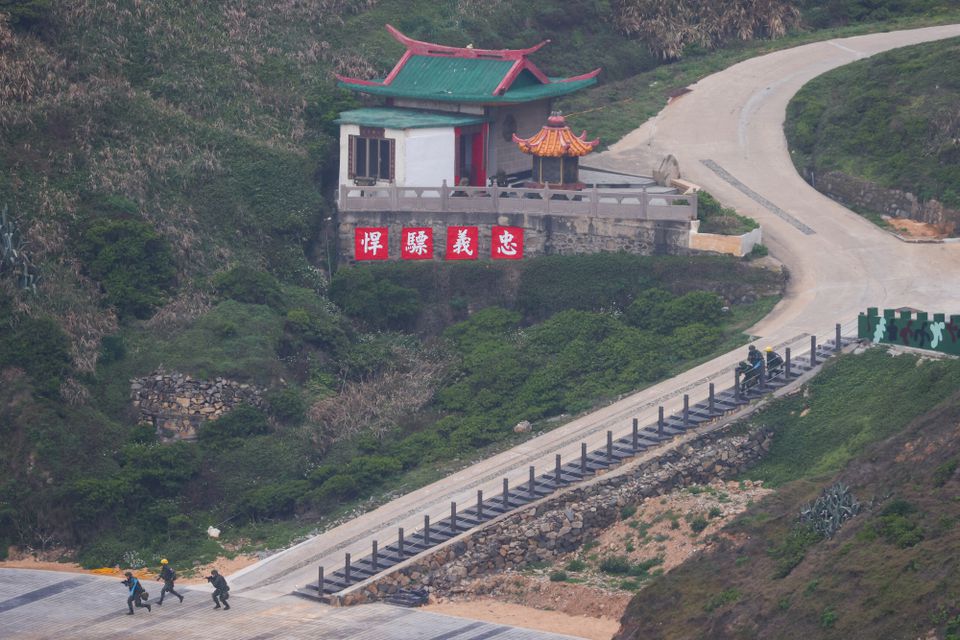
Soldiers run to position with a M72 LAW during a live drill in Dongyin, Taiwan, March 16, 2022. REUTERS
DONGYIN, Taiwan/TAIPEI — Taiwan held live fire drills in its northernmost territory on Wednesday, putting the spotlight on a remote island that is strategically located at a chokepoint near China – and potentially vulnerable to attack.
Although the defense ministry says the exercises on Dongyin, part of the Taiwan-controlled Matsu archipelago off the coast of China’s Fuzhou, are routine, they are happening as Taipei has raised its alert level after Russia’s invasion of Ukraine, wary of Beijing making a similar move.
Soldiers fired shells at a floating red cross in the water, meant to represent advancing enemy forces. Piercing the calm blue sea, each shell sent spray upwards.
The echoes of machine guns, punctuated by cannon fire, reverberated around the rugged coastline.
Although Taiwan has not reported any unusual activities by Beijing since the Ukraine war began, on Feb. 5 a small, propeller-driven Chinese aircraft flew very close to Dongyin. The highly unusual event thrust the normally sleepy islet into the headlines.
Taiwan said they suspected China was deploying a civilian aircraft to test the responses of its military.
Taiwan does not publish details of its military presence there, but the Dongyin Area Command has been at the front line of Taiwan’s defences since the 1950s.
Chieh Chung, researcher at the National Policy Foundation, a Taipei-based think tank, said Dongyin’s forces are equipped with Taiwan’s self-made Hsiung Feng II anti-ship missile as well as Sky Bow II surface-to-air missiles, making it “the most strategically important” outlying island.
Rocky Dongyin, reached by overnight boat from northern Taiwan’s Keelung port and home to some 1,500 civilians, sits on an important passage for any southbound Chinese forces from the eastern province of Zhejiang if they attack Taiwan.
“That’s why Dongyin is equipped with the Hsiung Feng and Sky Bow missiles. Dongyin poses a very direct threat to the Chinese Communist’s air and naval movements,” Chieh said.
At a February seminar in Taipei simulating a Chinese attack on Taiwan, retired Navy Rear Admiral Tan Chih-lung said Dongyin’s missile sites would be among the first targets of a Chinese attack.
“The People’s Liberation Army for sure will go destroy the Hsiung Feng missile base in Dongyin,” he said. “It’s a must-attack.”
A security official familiar with the deployment in Dongyin put the number of the troops there at around 1,100.
“The missile base there is at the very front lines to counter any attack with our missiles. If not for that, why would we value such a small place where the port is too small for bigger military ships and where there’s no airport for the air force?” said the official, who declined to be named because of the sensitivity of the matter.
A second security source acknowledged that the Chinese aircraft that got close to Dongyin had highlighted its vulnerability and proved it was of great interest to China.
“It’s the key to control of the northern part of the Taiwan Strait,” the source added.
Sounds of gunfire
Taiwan has governed Matsu, and Kinmen to its south, since the defeated Republic of China government fled to Taipei at the end of the Chinese civil war in 1949.
Despite the presence of troops, Dongyin is not a closed island. Tourists can explore former military tunnels, take in the stark natural beauty and go fishing.
“We’re very used to these sounds,” said Dongyin township chief Lin Te-chien, as he observed Wednesday’s drills.
Taiwan does not have anywhere near the number of forces on Matsu and Kinmen as it did from the 1950s to late 1970s, when both island groups were regularly shelled by China.
But Matsu and Kinmen continue to preoccupy Taiwan’s strategists, who have been given new focus by the war in Ukraine.
Defence Minister Chiu Kuo-cheng told lawmakers this month that China could draw lessons from the war in Ukraine and “speed up” their pace of any assault on Taiwan, perhaps attacking the outlying islands and at the same time starting precision missile strikes on targets in Taiwan, while sending troops across the strait.
China now has the capacity to take Kinmen and other outlying islands, Chiu said.
“But why have they not done it?” he asked. “Because they want to make sure that they can settle everything with one strike.”
RELATED STORIES
Taiwan says China closed off part of South China Sea to look for crashed plane
US carriers in South China Sea, Taiwan reports further Chinese incursion
China says it warned away US warship in South China Sea
Taiwan warns Chinese aircraft in its air defense zone